Hofstede Model: Cultural Comparison of Australia and Singapore
VerifiedAdded on 2021/04/21
|12
|3069
|192
Essay
AI Summary
This essay provides a comparative analysis of Australia and Singapore using Hofstede's cultural dimensions framework. It explores how cultural values, including power distance, individualism versus collectivism, masculinity versus femininity, uncertainty avoidance, long-term versus short-term orientation, and indulgence versus restraint, influence leadership styles and change management strategies in both countries. The essay discusses the application of different sources of power—coercive, reward, legitimate, expert, and referent—within the context of each cultural dimension. It highlights how the Hofstede model can inform effective leadership approaches and change implementation processes, considering the unique cultural characteristics of Australia and Singapore. The analysis suggests that understanding these cultural nuances is crucial for successful organizational strategies and cross-cultural communication. The essay further examines the implications of these cultural differences on employee behavior and organizational dynamics, providing valuable insights for managers and leaders operating in these diverse cultural contexts.
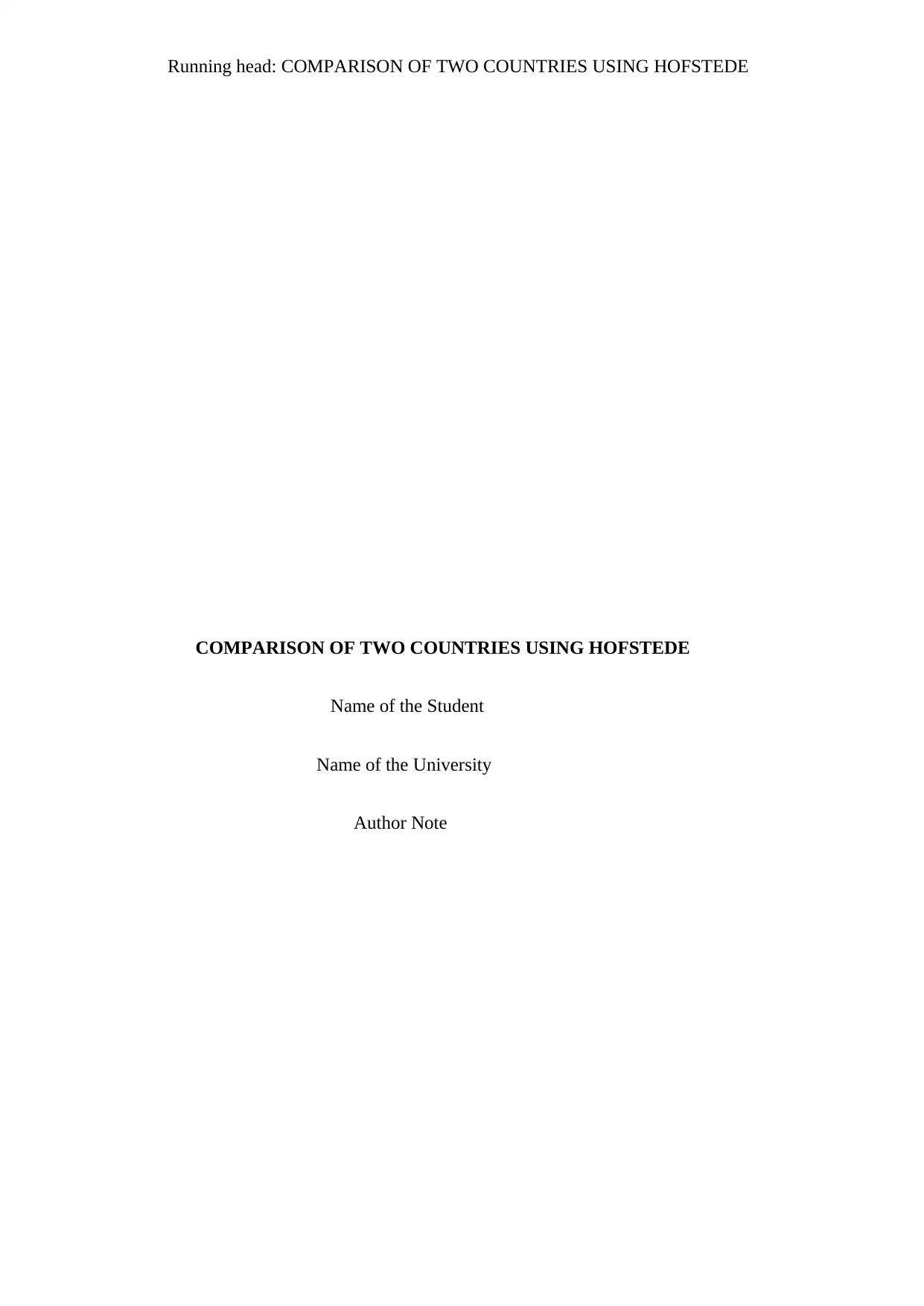
Running head: COMPARISON OF TWO COUNTRIES USING HOFSTEDE
COMPARISON OF TWO COUNTRIES USING HOFSTEDE
Name of the Student
Name of the University
Author Note
COMPARISON OF TWO COUNTRIES USING HOFSTEDE
Name of the Student
Name of the University
Author Note
Paraphrase This Document
Need a fresh take? Get an instant paraphrase of this document with our AI Paraphraser
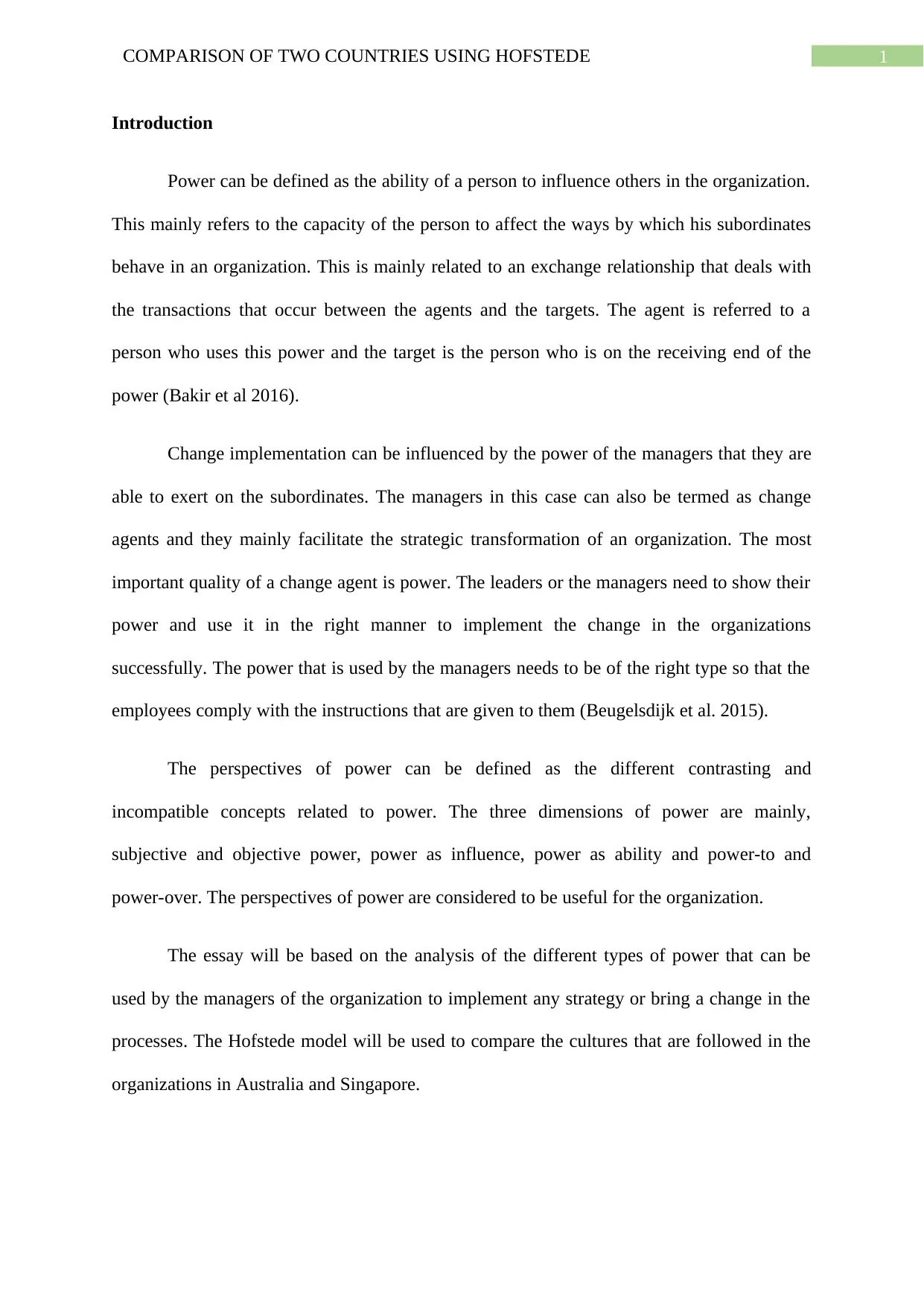
1COMPARISON OF TWO COUNTRIES USING HOFSTEDE
Introduction
Power can be defined as the ability of a person to influence others in the organization.
This mainly refers to the capacity of the person to affect the ways by which his subordinates
behave in an organization. This is mainly related to an exchange relationship that deals with
the transactions that occur between the agents and the targets. The agent is referred to a
person who uses this power and the target is the person who is on the receiving end of the
power (Bakir et al 2016).
Change implementation can be influenced by the power of the managers that they are
able to exert on the subordinates. The managers in this case can also be termed as change
agents and they mainly facilitate the strategic transformation of an organization. The most
important quality of a change agent is power. The leaders or the managers need to show their
power and use it in the right manner to implement the change in the organizations
successfully. The power that is used by the managers needs to be of the right type so that the
employees comply with the instructions that are given to them (Beugelsdijk et al. 2015).
The perspectives of power can be defined as the different contrasting and
incompatible concepts related to power. The three dimensions of power are mainly,
subjective and objective power, power as influence, power as ability and power-to and
power-over. The perspectives of power are considered to be useful for the organization.
The essay will be based on the analysis of the different types of power that can be
used by the managers of the organization to implement any strategy or bring a change in the
processes. The Hofstede model will be used to compare the cultures that are followed in the
organizations in Australia and Singapore.
Introduction
Power can be defined as the ability of a person to influence others in the organization.
This mainly refers to the capacity of the person to affect the ways by which his subordinates
behave in an organization. This is mainly related to an exchange relationship that deals with
the transactions that occur between the agents and the targets. The agent is referred to a
person who uses this power and the target is the person who is on the receiving end of the
power (Bakir et al 2016).
Change implementation can be influenced by the power of the managers that they are
able to exert on the subordinates. The managers in this case can also be termed as change
agents and they mainly facilitate the strategic transformation of an organization. The most
important quality of a change agent is power. The leaders or the managers need to show their
power and use it in the right manner to implement the change in the organizations
successfully. The power that is used by the managers needs to be of the right type so that the
employees comply with the instructions that are given to them (Beugelsdijk et al. 2015).
The perspectives of power can be defined as the different contrasting and
incompatible concepts related to power. The three dimensions of power are mainly,
subjective and objective power, power as influence, power as ability and power-to and
power-over. The perspectives of power are considered to be useful for the organization.
The essay will be based on the analysis of the different types of power that can be
used by the managers of the organization to implement any strategy or bring a change in the
processes. The Hofstede model will be used to compare the cultures that are followed in the
organizations in Australia and Singapore.
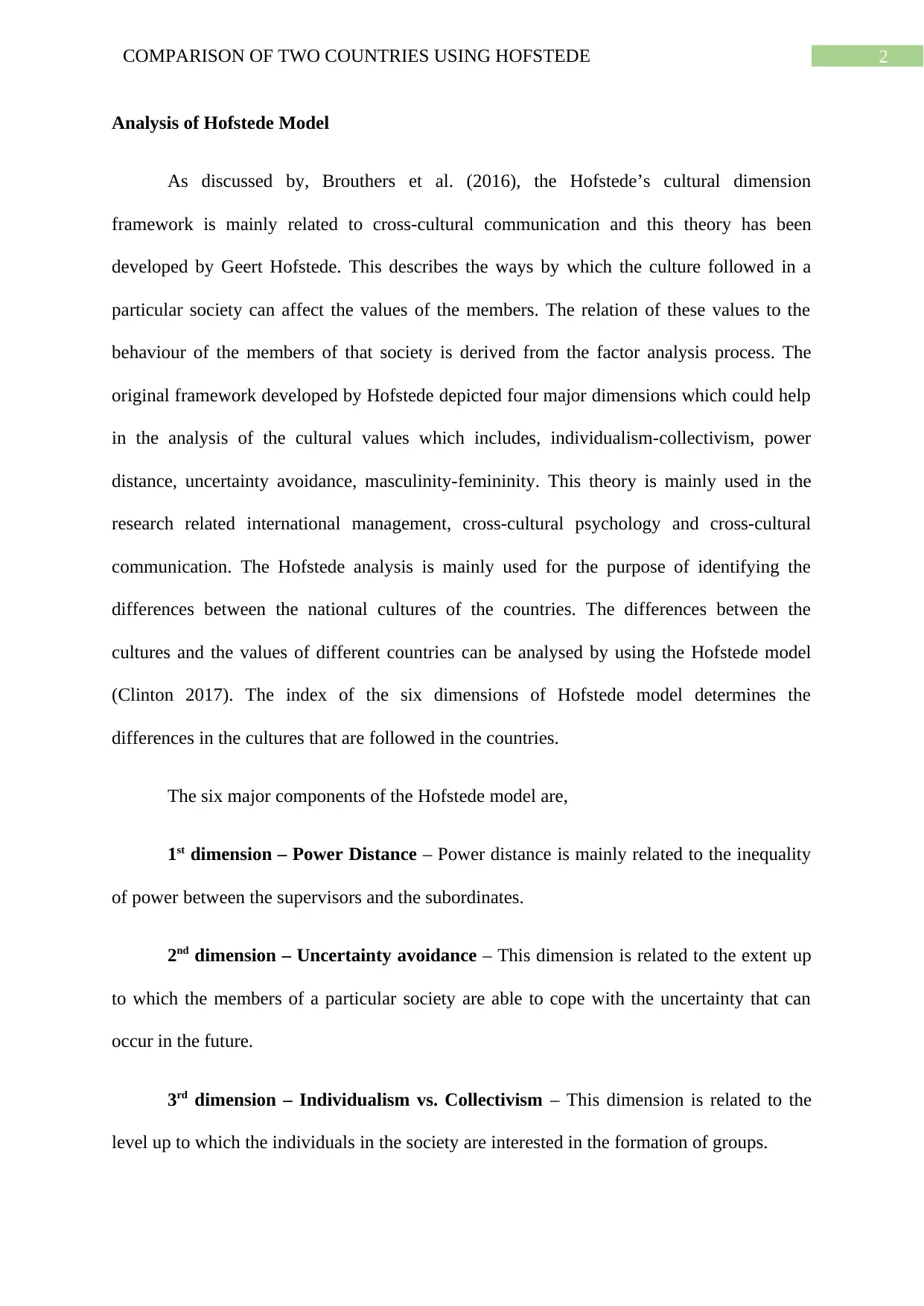
2COMPARISON OF TWO COUNTRIES USING HOFSTEDE
Analysis of Hofstede Model
As discussed by, Brouthers et al. (2016), the Hofstede’s cultural dimension
framework is mainly related to cross-cultural communication and this theory has been
developed by Geert Hofstede. This describes the ways by which the culture followed in a
particular society can affect the values of the members. The relation of these values to the
behaviour of the members of that society is derived from the factor analysis process. The
original framework developed by Hofstede depicted four major dimensions which could help
in the analysis of the cultural values which includes, individualism-collectivism, power
distance, uncertainty avoidance, masculinity-femininity. This theory is mainly used in the
research related international management, cross-cultural psychology and cross-cultural
communication. The Hofstede analysis is mainly used for the purpose of identifying the
differences between the national cultures of the countries. The differences between the
cultures and the values of different countries can be analysed by using the Hofstede model
(Clinton 2017). The index of the six dimensions of Hofstede model determines the
differences in the cultures that are followed in the countries.
The six major components of the Hofstede model are,
1st dimension – Power Distance – Power distance is mainly related to the inequality
of power between the supervisors and the subordinates.
2nd dimension – Uncertainty avoidance – This dimension is related to the extent up
to which the members of a particular society are able to cope with the uncertainty that can
occur in the future.
3rd dimension – Individualism vs. Collectivism – This dimension is related to the
level up to which the individuals in the society are interested in the formation of groups.
Analysis of Hofstede Model
As discussed by, Brouthers et al. (2016), the Hofstede’s cultural dimension
framework is mainly related to cross-cultural communication and this theory has been
developed by Geert Hofstede. This describes the ways by which the culture followed in a
particular society can affect the values of the members. The relation of these values to the
behaviour of the members of that society is derived from the factor analysis process. The
original framework developed by Hofstede depicted four major dimensions which could help
in the analysis of the cultural values which includes, individualism-collectivism, power
distance, uncertainty avoidance, masculinity-femininity. This theory is mainly used in the
research related international management, cross-cultural psychology and cross-cultural
communication. The Hofstede analysis is mainly used for the purpose of identifying the
differences between the national cultures of the countries. The differences between the
cultures and the values of different countries can be analysed by using the Hofstede model
(Clinton 2017). The index of the six dimensions of Hofstede model determines the
differences in the cultures that are followed in the countries.
The six major components of the Hofstede model are,
1st dimension – Power Distance – Power distance is mainly related to the inequality
of power between the supervisors and the subordinates.
2nd dimension – Uncertainty avoidance – This dimension is related to the extent up
to which the members of a particular society are able to cope with the uncertainty that can
occur in the future.
3rd dimension – Individualism vs. Collectivism – This dimension is related to the
level up to which the individuals in the society are interested in the formation of groups.
⊘ This is a preview!⊘
Do you want full access?
Subscribe today to unlock all pages.

Trusted by 1+ million students worldwide
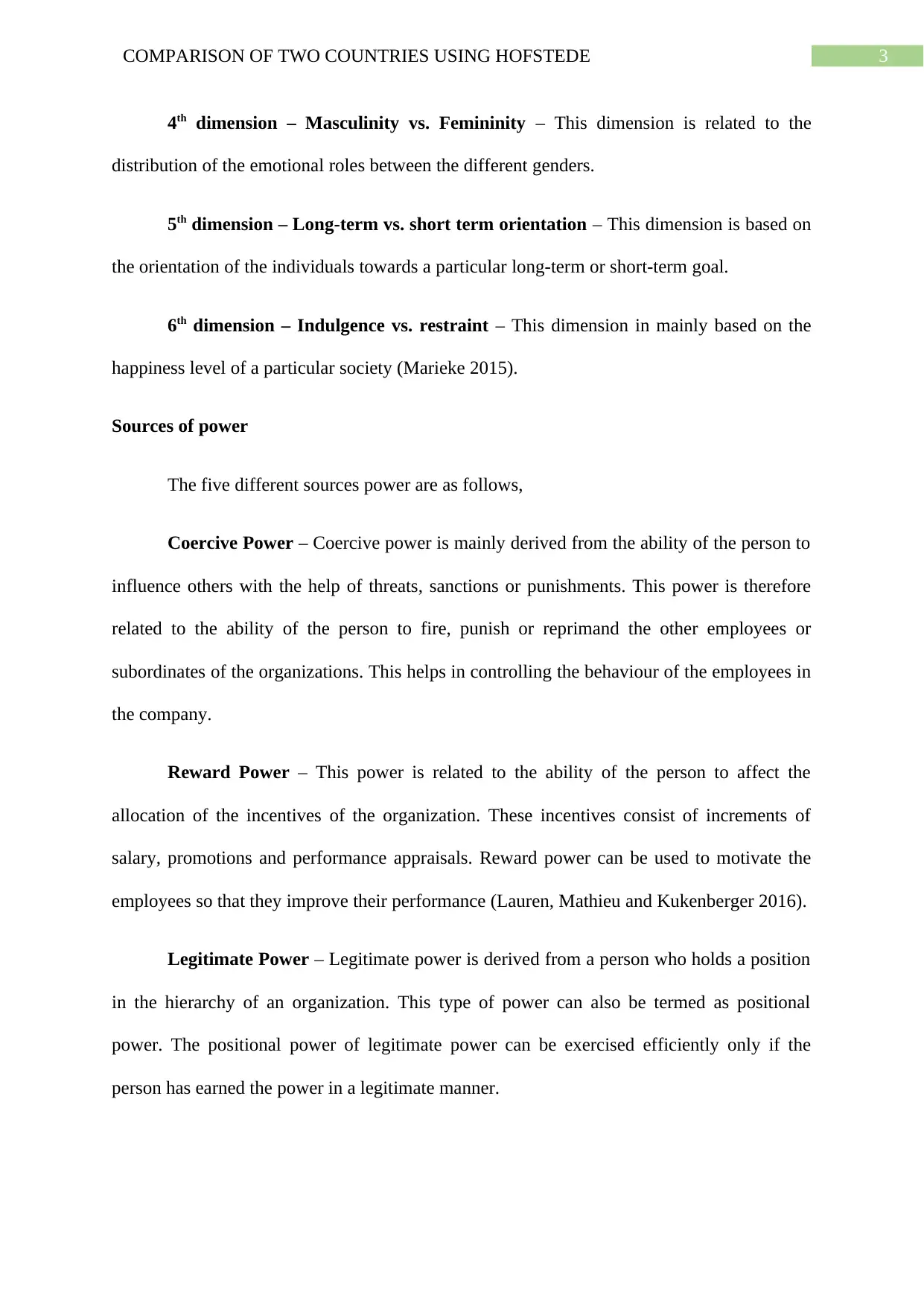
3COMPARISON OF TWO COUNTRIES USING HOFSTEDE
4th dimension – Masculinity vs. Femininity – This dimension is related to the
distribution of the emotional roles between the different genders.
5th dimension – Long-term vs. short term orientation – This dimension is based on
the orientation of the individuals towards a particular long-term or short-term goal.
6th dimension – Indulgence vs. restraint – This dimension in mainly based on the
happiness level of a particular society (Marieke 2015).
Sources of power
The five different sources power are as follows,
Coercive Power – Coercive power is mainly derived from the ability of the person to
influence others with the help of threats, sanctions or punishments. This power is therefore
related to the ability of the person to fire, punish or reprimand the other employees or
subordinates of the organizations. This helps in controlling the behaviour of the employees in
the company.
Reward Power – This power is related to the ability of the person to affect the
allocation of the incentives of the organization. These incentives consist of increments of
salary, promotions and performance appraisals. Reward power can be used to motivate the
employees so that they improve their performance (Lauren, Mathieu and Kukenberger 2016).
Legitimate Power – Legitimate power is derived from a person who holds a position
in the hierarchy of an organization. This type of power can also be termed as positional
power. The positional power of legitimate power can be exercised efficiently only if the
person has earned the power in a legitimate manner.
4th dimension – Masculinity vs. Femininity – This dimension is related to the
distribution of the emotional roles between the different genders.
5th dimension – Long-term vs. short term orientation – This dimension is based on
the orientation of the individuals towards a particular long-term or short-term goal.
6th dimension – Indulgence vs. restraint – This dimension in mainly based on the
happiness level of a particular society (Marieke 2015).
Sources of power
The five different sources power are as follows,
Coercive Power – Coercive power is mainly derived from the ability of the person to
influence others with the help of threats, sanctions or punishments. This power is therefore
related to the ability of the person to fire, punish or reprimand the other employees or
subordinates of the organizations. This helps in controlling the behaviour of the employees in
the company.
Reward Power – This power is related to the ability of the person to affect the
allocation of the incentives of the organization. These incentives consist of increments of
salary, promotions and performance appraisals. Reward power can be used to motivate the
employees so that they improve their performance (Lauren, Mathieu and Kukenberger 2016).
Legitimate Power – Legitimate power is derived from a person who holds a position
in the hierarchy of an organization. This type of power can also be termed as positional
power. The positional power of legitimate power can be exercised efficiently only if the
person has earned the power in a legitimate manner.
Paraphrase This Document
Need a fresh take? Get an instant paraphrase of this document with our AI Paraphraser
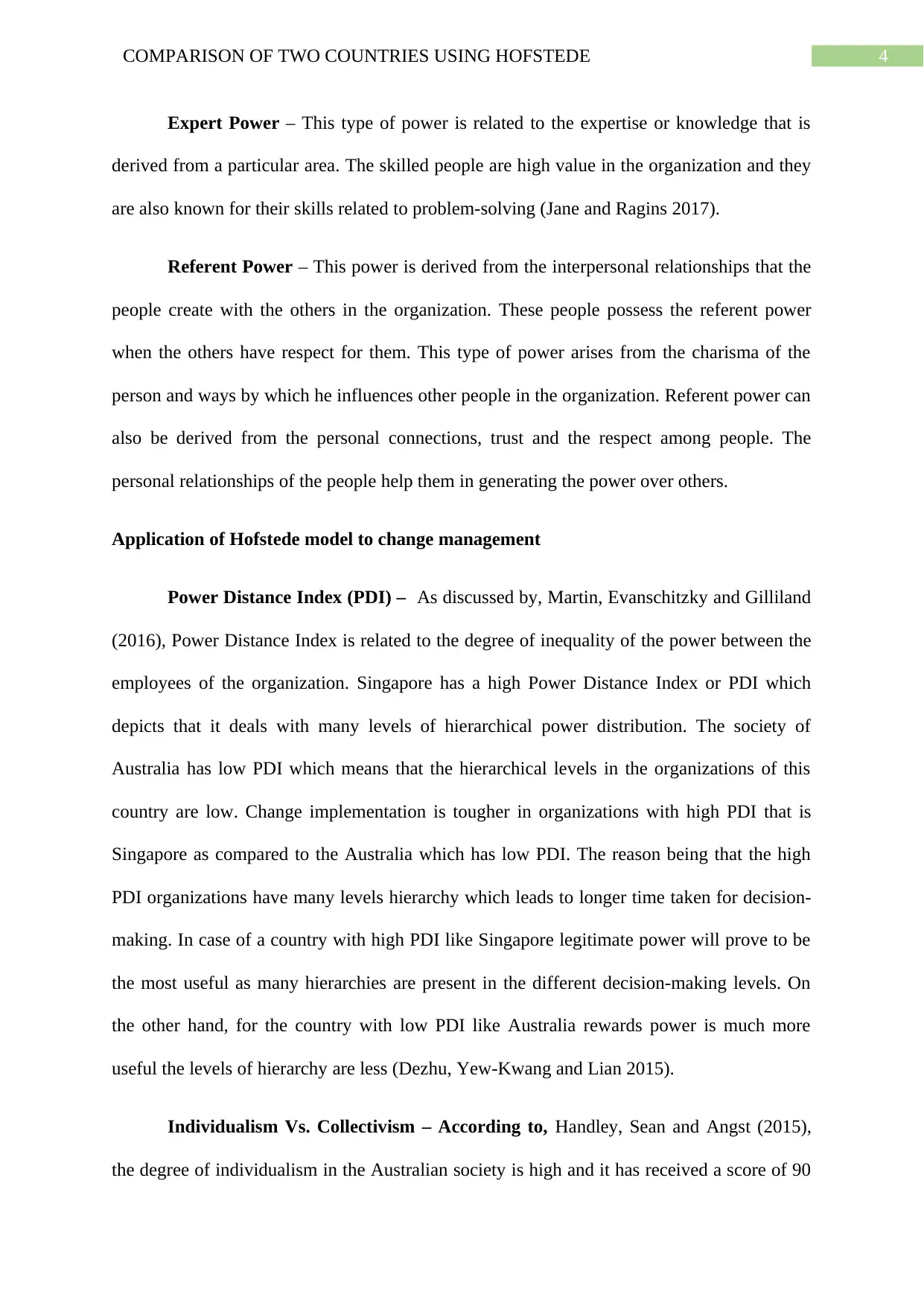
4COMPARISON OF TWO COUNTRIES USING HOFSTEDE
Expert Power – This type of power is related to the expertise or knowledge that is
derived from a particular area. The skilled people are high value in the organization and they
are also known for their skills related to problem-solving (Jane and Ragins 2017).
Referent Power – This power is derived from the interpersonal relationships that the
people create with the others in the organization. These people possess the referent power
when the others have respect for them. This type of power arises from the charisma of the
person and ways by which he influences other people in the organization. Referent power can
also be derived from the personal connections, trust and the respect among people. The
personal relationships of the people help them in generating the power over others.
Application of Hofstede model to change management
Power Distance Index (PDI) – As discussed by, Martin, Evanschitzky and Gilliland
(2016), Power Distance Index is related to the degree of inequality of the power between the
employees of the organization. Singapore has a high Power Distance Index or PDI which
depicts that it deals with many levels of hierarchical power distribution. The society of
Australia has low PDI which means that the hierarchical levels in the organizations of this
country are low. Change implementation is tougher in organizations with high PDI that is
Singapore as compared to the Australia which has low PDI. The reason being that the high
PDI organizations have many levels hierarchy which leads to longer time taken for decision-
making. In case of a country with high PDI like Singapore legitimate power will prove to be
the most useful as many hierarchies are present in the different decision-making levels. On
the other hand, for the country with low PDI like Australia rewards power is much more
useful the levels of hierarchy are less (Dezhu, Yew-Kwang and Lian 2015).
Individualism Vs. Collectivism – According to, Handley, Sean and Angst (2015),
the degree of individualism in the Australian society is high and it has received a score of 90
Expert Power – This type of power is related to the expertise or knowledge that is
derived from a particular area. The skilled people are high value in the organization and they
are also known for their skills related to problem-solving (Jane and Ragins 2017).
Referent Power – This power is derived from the interpersonal relationships that the
people create with the others in the organization. These people possess the referent power
when the others have respect for them. This type of power arises from the charisma of the
person and ways by which he influences other people in the organization. Referent power can
also be derived from the personal connections, trust and the respect among people. The
personal relationships of the people help them in generating the power over others.
Application of Hofstede model to change management
Power Distance Index (PDI) – As discussed by, Martin, Evanschitzky and Gilliland
(2016), Power Distance Index is related to the degree of inequality of the power between the
employees of the organization. Singapore has a high Power Distance Index or PDI which
depicts that it deals with many levels of hierarchical power distribution. The society of
Australia has low PDI which means that the hierarchical levels in the organizations of this
country are low. Change implementation is tougher in organizations with high PDI that is
Singapore as compared to the Australia which has low PDI. The reason being that the high
PDI organizations have many levels hierarchy which leads to longer time taken for decision-
making. In case of a country with high PDI like Singapore legitimate power will prove to be
the most useful as many hierarchies are present in the different decision-making levels. On
the other hand, for the country with low PDI like Australia rewards power is much more
useful the levels of hierarchy are less (Dezhu, Yew-Kwang and Lian 2015).
Individualism Vs. Collectivism – According to, Handley, Sean and Angst (2015),
the degree of individualism in the Australian society is high and it has received a score of 90
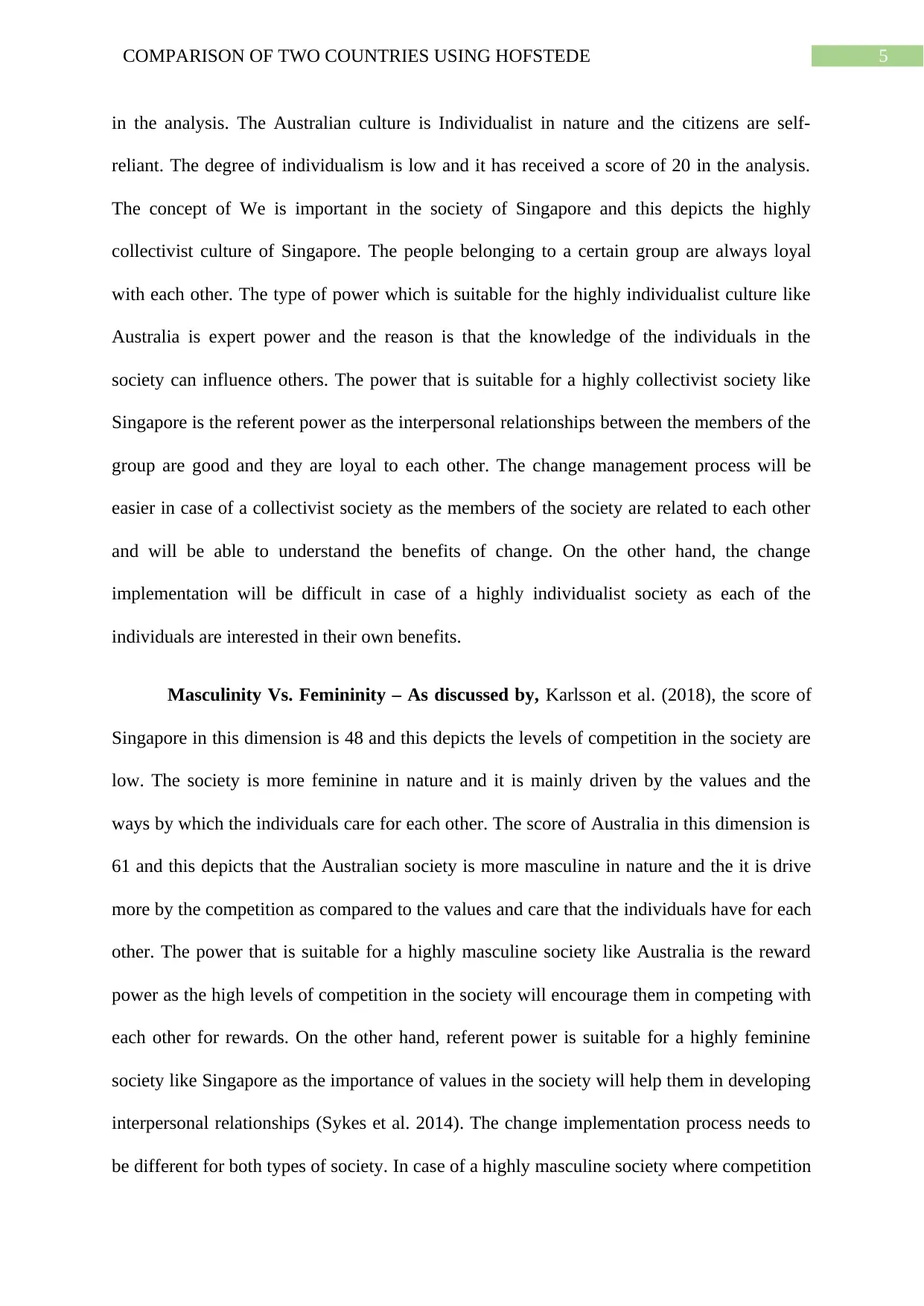
5COMPARISON OF TWO COUNTRIES USING HOFSTEDE
in the analysis. The Australian culture is Individualist in nature and the citizens are self-
reliant. The degree of individualism is low and it has received a score of 20 in the analysis.
The concept of We is important in the society of Singapore and this depicts the highly
collectivist culture of Singapore. The people belonging to a certain group are always loyal
with each other. The type of power which is suitable for the highly individualist culture like
Australia is expert power and the reason is that the knowledge of the individuals in the
society can influence others. The power that is suitable for a highly collectivist society like
Singapore is the referent power as the interpersonal relationships between the members of the
group are good and they are loyal to each other. The change management process will be
easier in case of a collectivist society as the members of the society are related to each other
and will be able to understand the benefits of change. On the other hand, the change
implementation will be difficult in case of a highly individualist society as each of the
individuals are interested in their own benefits.
Masculinity Vs. Femininity – As discussed by, Karlsson et al. (2018), the score of
Singapore in this dimension is 48 and this depicts the levels of competition in the society are
low. The society is more feminine in nature and it is mainly driven by the values and the
ways by which the individuals care for each other. The score of Australia in this dimension is
61 and this depicts that the Australian society is more masculine in nature and the it is drive
more by the competition as compared to the values and care that the individuals have for each
other. The power that is suitable for a highly masculine society like Australia is the reward
power as the high levels of competition in the society will encourage them in competing with
each other for rewards. On the other hand, referent power is suitable for a highly feminine
society like Singapore as the importance of values in the society will help them in developing
interpersonal relationships (Sykes et al. 2014). The change implementation process needs to
be different for both types of society. In case of a highly masculine society where competition
in the analysis. The Australian culture is Individualist in nature and the citizens are self-
reliant. The degree of individualism is low and it has received a score of 20 in the analysis.
The concept of We is important in the society of Singapore and this depicts the highly
collectivist culture of Singapore. The people belonging to a certain group are always loyal
with each other. The type of power which is suitable for the highly individualist culture like
Australia is expert power and the reason is that the knowledge of the individuals in the
society can influence others. The power that is suitable for a highly collectivist society like
Singapore is the referent power as the interpersonal relationships between the members of the
group are good and they are loyal to each other. The change management process will be
easier in case of a collectivist society as the members of the society are related to each other
and will be able to understand the benefits of change. On the other hand, the change
implementation will be difficult in case of a highly individualist society as each of the
individuals are interested in their own benefits.
Masculinity Vs. Femininity – As discussed by, Karlsson et al. (2018), the score of
Singapore in this dimension is 48 and this depicts the levels of competition in the society are
low. The society is more feminine in nature and it is mainly driven by the values and the
ways by which the individuals care for each other. The score of Australia in this dimension is
61 and this depicts that the Australian society is more masculine in nature and the it is drive
more by the competition as compared to the values and care that the individuals have for each
other. The power that is suitable for a highly masculine society like Australia is the reward
power as the high levels of competition in the society will encourage them in competing with
each other for rewards. On the other hand, referent power is suitable for a highly feminine
society like Singapore as the importance of values in the society will help them in developing
interpersonal relationships (Sykes et al. 2014). The change implementation process needs to
be different for both types of society. In case of a highly masculine society where competition
⊘ This is a preview!⊘
Do you want full access?
Subscribe today to unlock all pages.

Trusted by 1+ million students worldwide
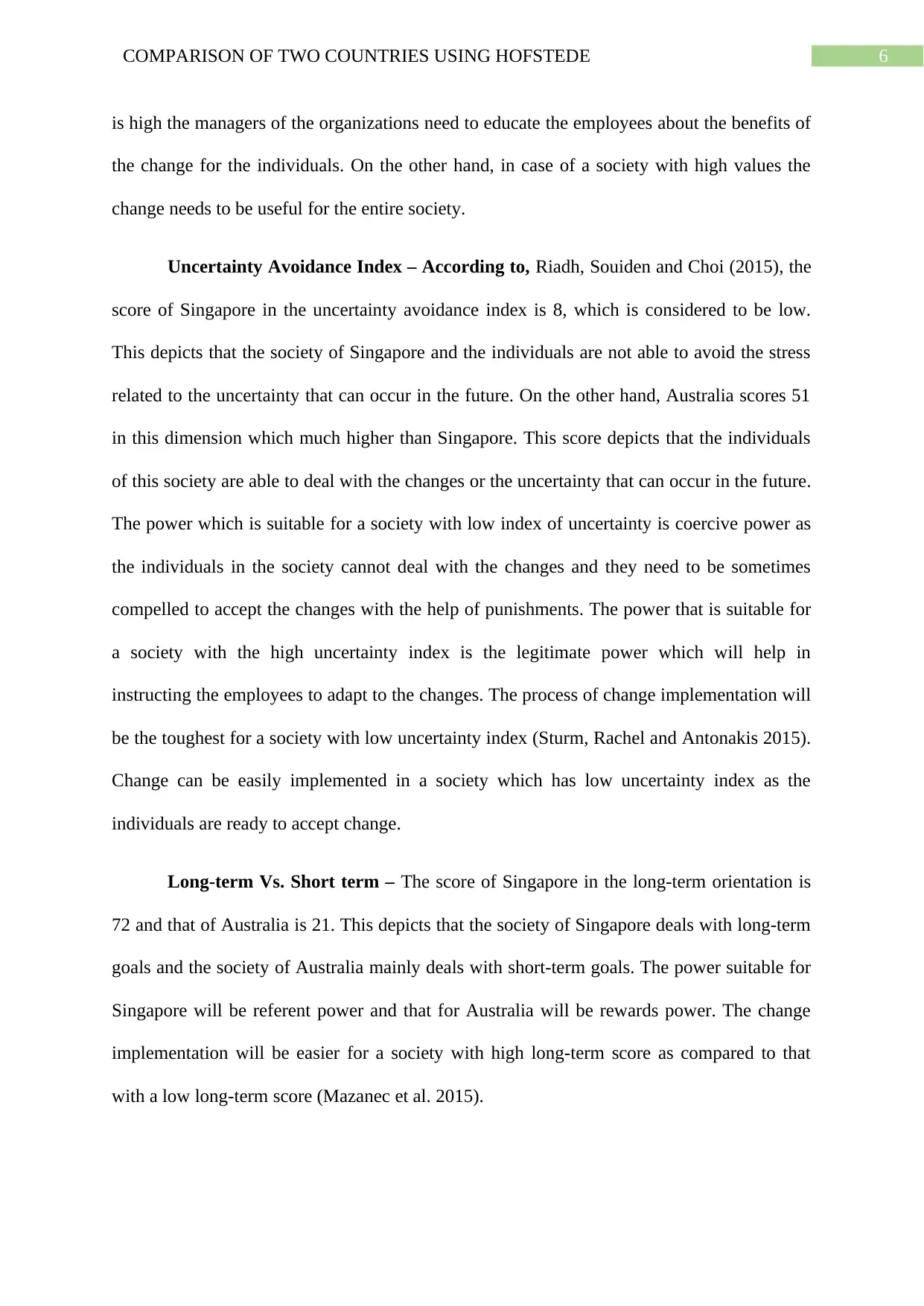
6COMPARISON OF TWO COUNTRIES USING HOFSTEDE
is high the managers of the organizations need to educate the employees about the benefits of
the change for the individuals. On the other hand, in case of a society with high values the
change needs to be useful for the entire society.
Uncertainty Avoidance Index – According to, Riadh, Souiden and Choi (2015), the
score of Singapore in the uncertainty avoidance index is 8, which is considered to be low.
This depicts that the society of Singapore and the individuals are not able to avoid the stress
related to the uncertainty that can occur in the future. On the other hand, Australia scores 51
in this dimension which much higher than Singapore. This score depicts that the individuals
of this society are able to deal with the changes or the uncertainty that can occur in the future.
The power which is suitable for a society with low index of uncertainty is coercive power as
the individuals in the society cannot deal with the changes and they need to be sometimes
compelled to accept the changes with the help of punishments. The power that is suitable for
a society with the high uncertainty index is the legitimate power which will help in
instructing the employees to adapt to the changes. The process of change implementation will
be the toughest for a society with low uncertainty index (Sturm, Rachel and Antonakis 2015).
Change can be easily implemented in a society which has low uncertainty index as the
individuals are ready to accept change.
Long-term Vs. Short term – The score of Singapore in the long-term orientation is
72 and that of Australia is 21. This depicts that the society of Singapore deals with long-term
goals and the society of Australia mainly deals with short-term goals. The power suitable for
Singapore will be referent power and that for Australia will be rewards power. The change
implementation will be easier for a society with high long-term score as compared to that
with a low long-term score (Mazanec et al. 2015).
is high the managers of the organizations need to educate the employees about the benefits of
the change for the individuals. On the other hand, in case of a society with high values the
change needs to be useful for the entire society.
Uncertainty Avoidance Index – According to, Riadh, Souiden and Choi (2015), the
score of Singapore in the uncertainty avoidance index is 8, which is considered to be low.
This depicts that the society of Singapore and the individuals are not able to avoid the stress
related to the uncertainty that can occur in the future. On the other hand, Australia scores 51
in this dimension which much higher than Singapore. This score depicts that the individuals
of this society are able to deal with the changes or the uncertainty that can occur in the future.
The power which is suitable for a society with low index of uncertainty is coercive power as
the individuals in the society cannot deal with the changes and they need to be sometimes
compelled to accept the changes with the help of punishments. The power that is suitable for
a society with the high uncertainty index is the legitimate power which will help in
instructing the employees to adapt to the changes. The process of change implementation will
be the toughest for a society with low uncertainty index (Sturm, Rachel and Antonakis 2015).
Change can be easily implemented in a society which has low uncertainty index as the
individuals are ready to accept change.
Long-term Vs. Short term – The score of Singapore in the long-term orientation is
72 and that of Australia is 21. This depicts that the society of Singapore deals with long-term
goals and the society of Australia mainly deals with short-term goals. The power suitable for
Singapore will be referent power and that for Australia will be rewards power. The change
implementation will be easier for a society with high long-term score as compared to that
with a low long-term score (Mazanec et al. 2015).
Paraphrase This Document
Need a fresh take? Get an instant paraphrase of this document with our AI Paraphraser
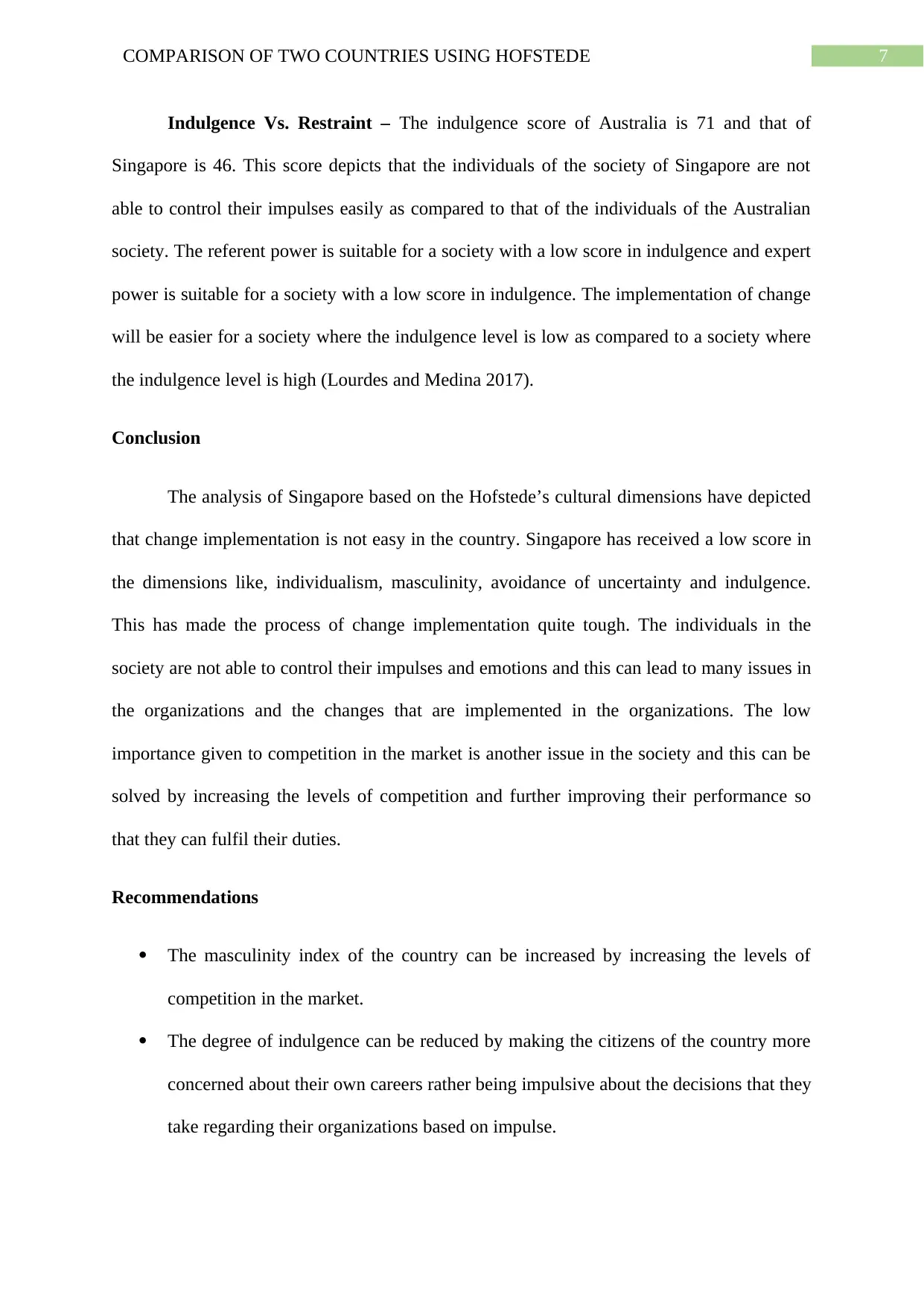
7COMPARISON OF TWO COUNTRIES USING HOFSTEDE
Indulgence Vs. Restraint – The indulgence score of Australia is 71 and that of
Singapore is 46. This score depicts that the individuals of the society of Singapore are not
able to control their impulses easily as compared to that of the individuals of the Australian
society. The referent power is suitable for a society with a low score in indulgence and expert
power is suitable for a society with a low score in indulgence. The implementation of change
will be easier for a society where the indulgence level is low as compared to a society where
the indulgence level is high (Lourdes and Medina 2017).
Conclusion
The analysis of Singapore based on the Hofstede’s cultural dimensions have depicted
that change implementation is not easy in the country. Singapore has received a low score in
the dimensions like, individualism, masculinity, avoidance of uncertainty and indulgence.
This has made the process of change implementation quite tough. The individuals in the
society are not able to control their impulses and emotions and this can lead to many issues in
the organizations and the changes that are implemented in the organizations. The low
importance given to competition in the market is another issue in the society and this can be
solved by increasing the levels of competition and further improving their performance so
that they can fulfil their duties.
Recommendations
The masculinity index of the country can be increased by increasing the levels of
competition in the market.
The degree of indulgence can be reduced by making the citizens of the country more
concerned about their own careers rather being impulsive about the decisions that they
take regarding their organizations based on impulse.
Indulgence Vs. Restraint – The indulgence score of Australia is 71 and that of
Singapore is 46. This score depicts that the individuals of the society of Singapore are not
able to control their impulses easily as compared to that of the individuals of the Australian
society. The referent power is suitable for a society with a low score in indulgence and expert
power is suitable for a society with a low score in indulgence. The implementation of change
will be easier for a society where the indulgence level is low as compared to a society where
the indulgence level is high (Lourdes and Medina 2017).
Conclusion
The analysis of Singapore based on the Hofstede’s cultural dimensions have depicted
that change implementation is not easy in the country. Singapore has received a low score in
the dimensions like, individualism, masculinity, avoidance of uncertainty and indulgence.
This has made the process of change implementation quite tough. The individuals in the
society are not able to control their impulses and emotions and this can lead to many issues in
the organizations and the changes that are implemented in the organizations. The low
importance given to competition in the market is another issue in the society and this can be
solved by increasing the levels of competition and further improving their performance so
that they can fulfil their duties.
Recommendations
The masculinity index of the country can be increased by increasing the levels of
competition in the market.
The degree of indulgence can be reduced by making the citizens of the country more
concerned about their own careers rather being impulsive about the decisions that they
take regarding their organizations based on impulse.
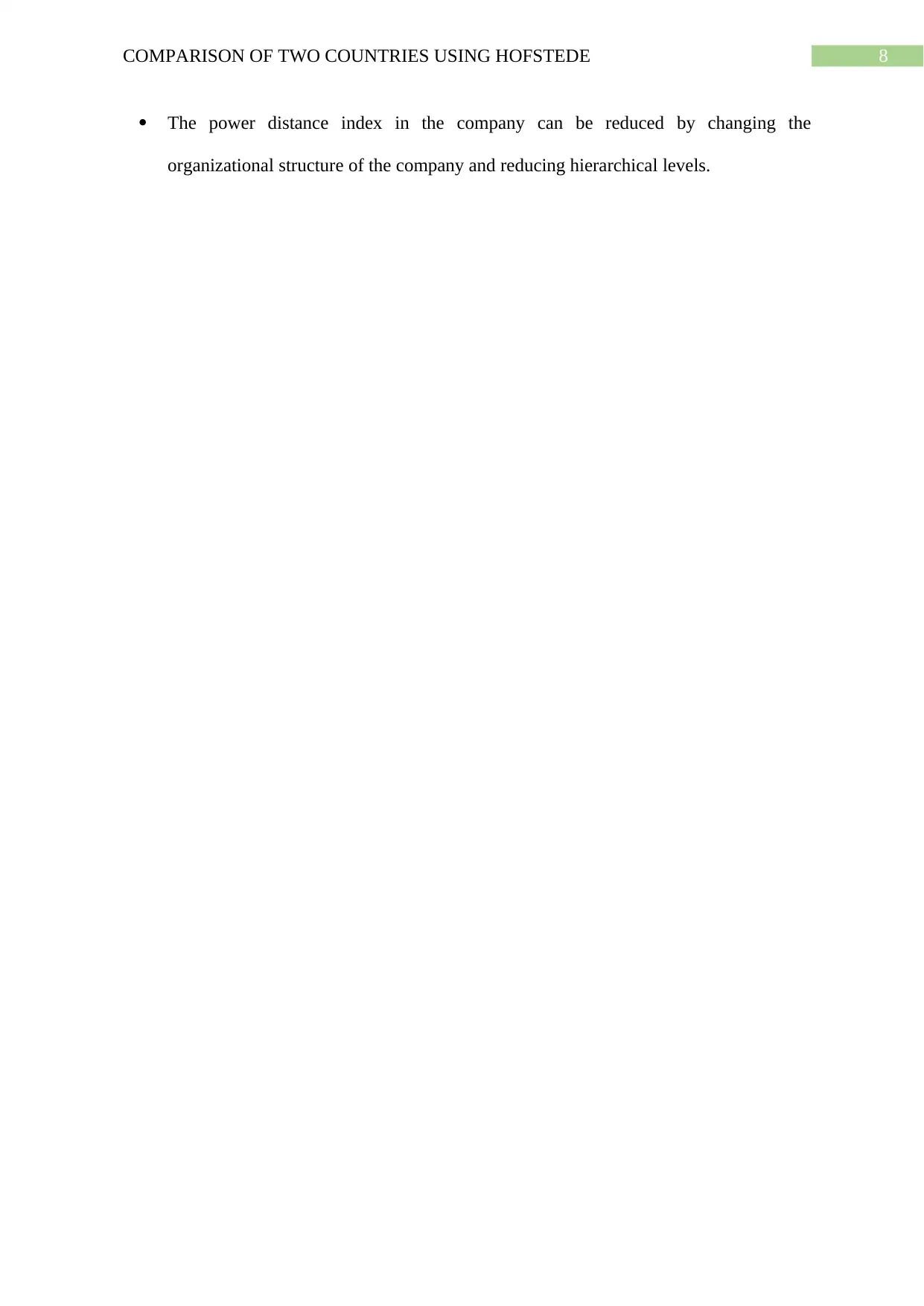
8COMPARISON OF TWO COUNTRIES USING HOFSTEDE
The power distance index in the company can be reduced by changing the
organizational structure of the company and reducing hierarchical levels.
The power distance index in the company can be reduced by changing the
organizational structure of the company and reducing hierarchical levels.
⊘ This is a preview!⊘
Do you want full access?
Subscribe today to unlock all pages.

Trusted by 1+ million students worldwide
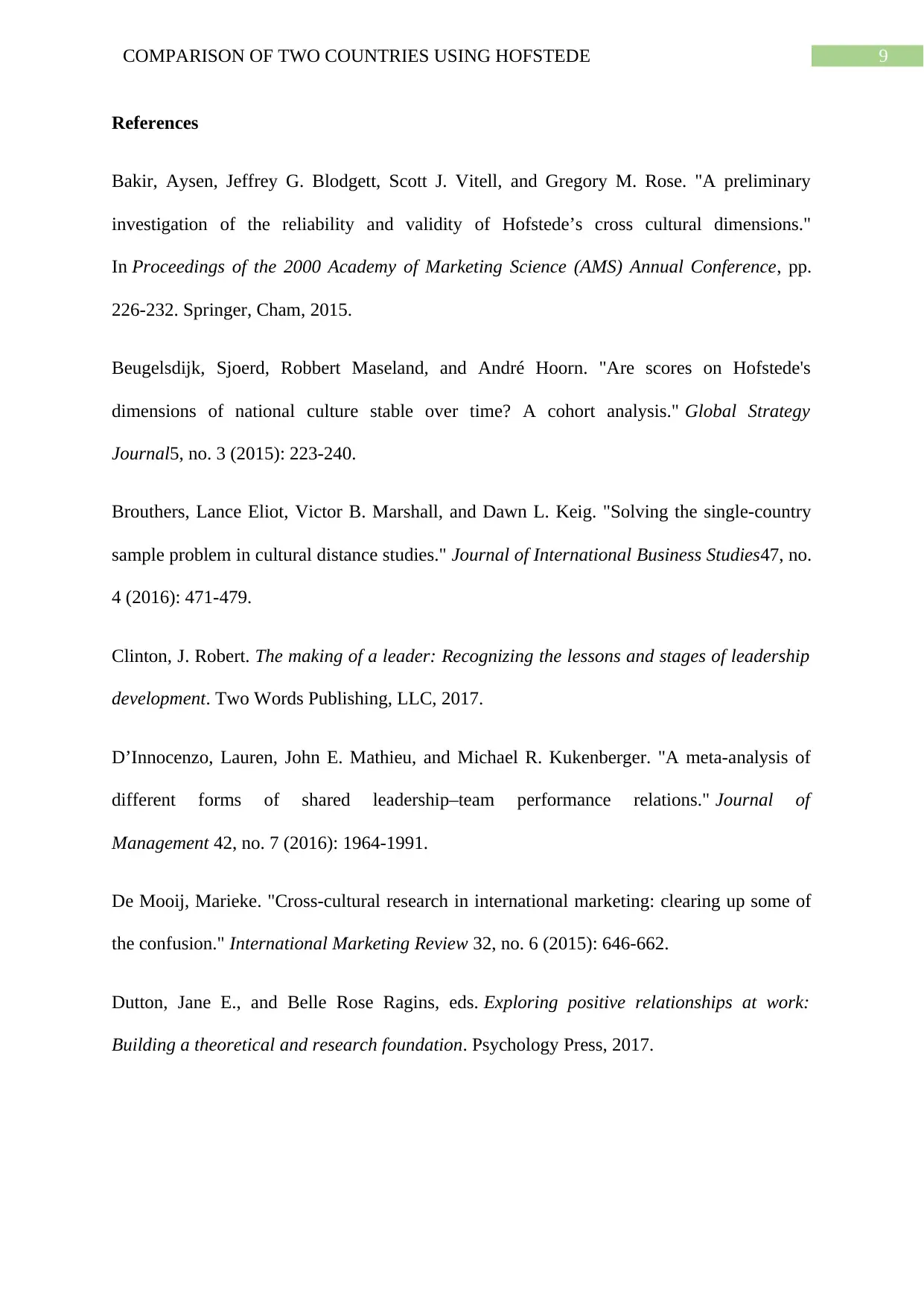
9COMPARISON OF TWO COUNTRIES USING HOFSTEDE
References
Bakir, Aysen, Jeffrey G. Blodgett, Scott J. Vitell, and Gregory M. Rose. "A preliminary
investigation of the reliability and validity of Hofstede’s cross cultural dimensions."
In Proceedings of the 2000 Academy of Marketing Science (AMS) Annual Conference, pp.
226-232. Springer, Cham, 2015.
Beugelsdijk, Sjoerd, Robbert Maseland, and André Hoorn. "Are scores on Hofstede's
dimensions of national culture stable over time? A cohort analysis." Global Strategy
Journal5, no. 3 (2015): 223-240.
Brouthers, Lance Eliot, Victor B. Marshall, and Dawn L. Keig. "Solving the single-country
sample problem in cultural distance studies." Journal of International Business Studies47, no.
4 (2016): 471-479.
Clinton, J. Robert. The making of a leader: Recognizing the lessons and stages of leadership
development. Two Words Publishing, LLC, 2017.
D’Innocenzo, Lauren, John E. Mathieu, and Michael R. Kukenberger. "A meta-analysis of
different forms of shared leadership–team performance relations." Journal of
Management 42, no. 7 (2016): 1964-1991.
De Mooij, Marieke. "Cross-cultural research in international marketing: clearing up some of
the confusion." International Marketing Review 32, no. 6 (2015): 646-662.
Dutton, Jane E., and Belle Rose Ragins, eds. Exploring positive relationships at work:
Building a theoretical and research foundation. Psychology Press, 2017.
References
Bakir, Aysen, Jeffrey G. Blodgett, Scott J. Vitell, and Gregory M. Rose. "A preliminary
investigation of the reliability and validity of Hofstede’s cross cultural dimensions."
In Proceedings of the 2000 Academy of Marketing Science (AMS) Annual Conference, pp.
226-232. Springer, Cham, 2015.
Beugelsdijk, Sjoerd, Robbert Maseland, and André Hoorn. "Are scores on Hofstede's
dimensions of national culture stable over time? A cohort analysis." Global Strategy
Journal5, no. 3 (2015): 223-240.
Brouthers, Lance Eliot, Victor B. Marshall, and Dawn L. Keig. "Solving the single-country
sample problem in cultural distance studies." Journal of International Business Studies47, no.
4 (2016): 471-479.
Clinton, J. Robert. The making of a leader: Recognizing the lessons and stages of leadership
development. Two Words Publishing, LLC, 2017.
D’Innocenzo, Lauren, John E. Mathieu, and Michael R. Kukenberger. "A meta-analysis of
different forms of shared leadership–team performance relations." Journal of
Management 42, no. 7 (2016): 1964-1991.
De Mooij, Marieke. "Cross-cultural research in international marketing: clearing up some of
the confusion." International Marketing Review 32, no. 6 (2015): 646-662.
Dutton, Jane E., and Belle Rose Ragins, eds. Exploring positive relationships at work:
Building a theoretical and research foundation. Psychology Press, 2017.
Paraphrase This Document
Need a fresh take? Get an instant paraphrase of this document with our AI Paraphraser
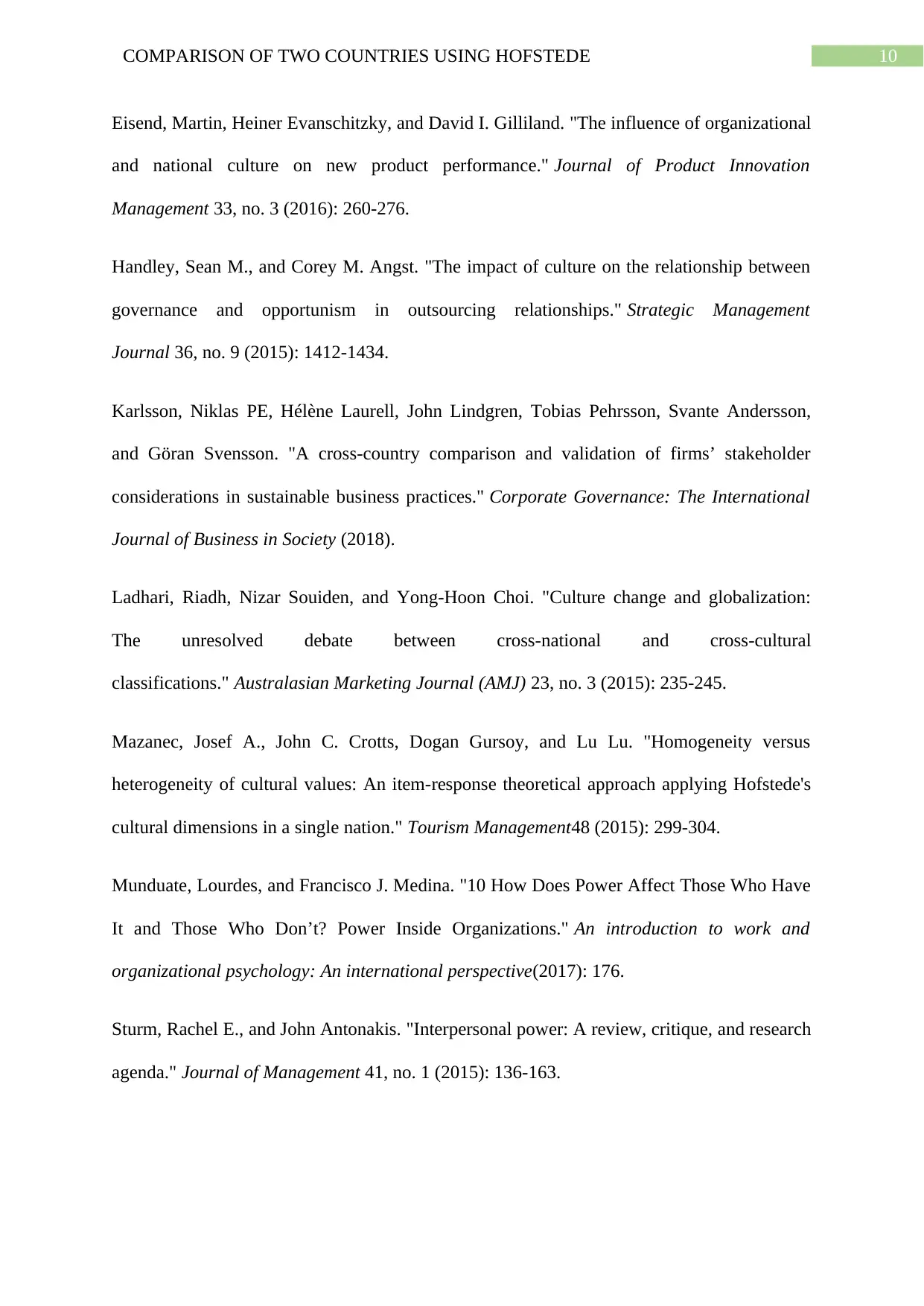
10COMPARISON OF TWO COUNTRIES USING HOFSTEDE
Eisend, Martin, Heiner Evanschitzky, and David I. Gilliland. "The influence of organizational
and national culture on new product performance." Journal of Product Innovation
Management 33, no. 3 (2016): 260-276.
Handley, Sean M., and Corey M. Angst. "The impact of culture on the relationship between
governance and opportunism in outsourcing relationships." Strategic Management
Journal 36, no. 9 (2015): 1412-1434.
Karlsson, Niklas PE, Hélène Laurell, John Lindgren, Tobias Pehrsson, Svante Andersson,
and Göran Svensson. "A cross-country comparison and validation of firms’ stakeholder
considerations in sustainable business practices." Corporate Governance: The International
Journal of Business in Society (2018).
Ladhari, Riadh, Nizar Souiden, and Yong-Hoon Choi. "Culture change and globalization:
The unresolved debate between cross-national and cross-cultural
classifications." Australasian Marketing Journal (AMJ) 23, no. 3 (2015): 235-245.
Mazanec, Josef A., John C. Crotts, Dogan Gursoy, and Lu Lu. "Homogeneity versus
heterogeneity of cultural values: An item-response theoretical approach applying Hofstede's
cultural dimensions in a single nation." Tourism Management48 (2015): 299-304.
Munduate, Lourdes, and Francisco J. Medina. "10 How Does Power Affect Those Who Have
It and Those Who Don’t? Power Inside Organizations." An introduction to work and
organizational psychology: An international perspective(2017): 176.
Sturm, Rachel E., and John Antonakis. "Interpersonal power: A review, critique, and research
agenda." Journal of Management 41, no. 1 (2015): 136-163.
Eisend, Martin, Heiner Evanschitzky, and David I. Gilliland. "The influence of organizational
and national culture on new product performance." Journal of Product Innovation
Management 33, no. 3 (2016): 260-276.
Handley, Sean M., and Corey M. Angst. "The impact of culture on the relationship between
governance and opportunism in outsourcing relationships." Strategic Management
Journal 36, no. 9 (2015): 1412-1434.
Karlsson, Niklas PE, Hélène Laurell, John Lindgren, Tobias Pehrsson, Svante Andersson,
and Göran Svensson. "A cross-country comparison and validation of firms’ stakeholder
considerations in sustainable business practices." Corporate Governance: The International
Journal of Business in Society (2018).
Ladhari, Riadh, Nizar Souiden, and Yong-Hoon Choi. "Culture change and globalization:
The unresolved debate between cross-national and cross-cultural
classifications." Australasian Marketing Journal (AMJ) 23, no. 3 (2015): 235-245.
Mazanec, Josef A., John C. Crotts, Dogan Gursoy, and Lu Lu. "Homogeneity versus
heterogeneity of cultural values: An item-response theoretical approach applying Hofstede's
cultural dimensions in a single nation." Tourism Management48 (2015): 299-304.
Munduate, Lourdes, and Francisco J. Medina. "10 How Does Power Affect Those Who Have
It and Those Who Don’t? Power Inside Organizations." An introduction to work and
organizational psychology: An international perspective(2017): 176.
Sturm, Rachel E., and John Antonakis. "Interpersonal power: A review, critique, and research
agenda." Journal of Management 41, no. 1 (2015): 136-163.
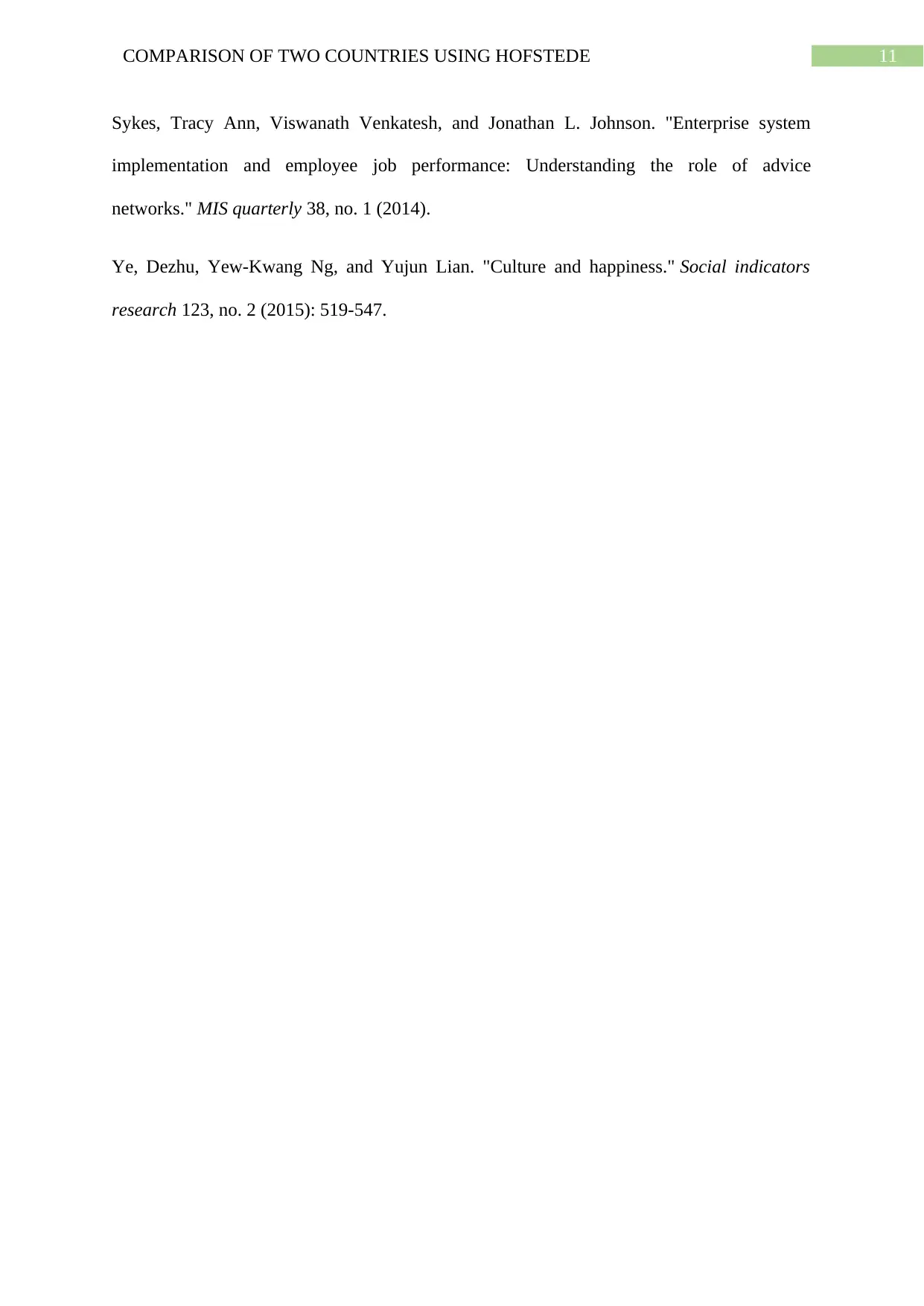
11COMPARISON OF TWO COUNTRIES USING HOFSTEDE
Sykes, Tracy Ann, Viswanath Venkatesh, and Jonathan L. Johnson. "Enterprise system
implementation and employee job performance: Understanding the role of advice
networks." MIS quarterly 38, no. 1 (2014).
Ye, Dezhu, Yew-Kwang Ng, and Yujun Lian. "Culture and happiness." Social indicators
research 123, no. 2 (2015): 519-547.
Sykes, Tracy Ann, Viswanath Venkatesh, and Jonathan L. Johnson. "Enterprise system
implementation and employee job performance: Understanding the role of advice
networks." MIS quarterly 38, no. 1 (2014).
Ye, Dezhu, Yew-Kwang Ng, and Yujun Lian. "Culture and happiness." Social indicators
research 123, no. 2 (2015): 519-547.
⊘ This is a preview!⊘
Do you want full access?
Subscribe today to unlock all pages.

Trusted by 1+ million students worldwide
1 out of 12
Related Documents
Your All-in-One AI-Powered Toolkit for Academic Success.
+13062052269
info@desklib.com
Available 24*7 on WhatsApp / Email
![[object Object]](/_next/static/media/star-bottom.7253800d.svg)
Unlock your academic potential
Copyright © 2020–2025 A2Z Services. All Rights Reserved. Developed and managed by ZUCOL.




